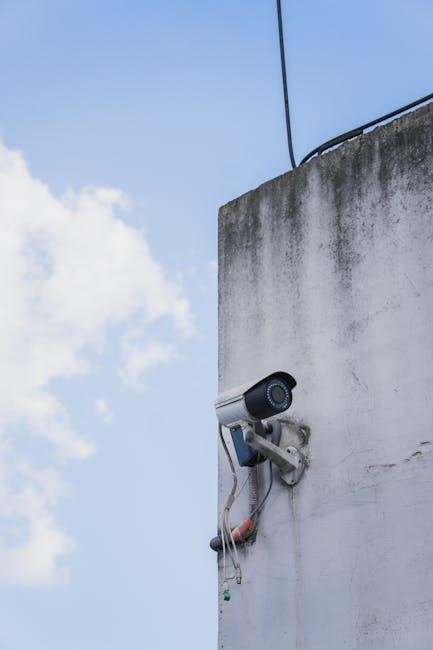The Midland Digital Weather/Hazard Alert Monitor is a crucial tool for emergency preparedness‚ providing real-time alerts for severe weather and hazards. Using S;A.M.E. technology‚ it ensures precise alerts for your area‚ offering peace of mind and essential information during critical situations.
Overview of the Device and Its Purpose
The Midland Digital Weather/Hazard Alert Monitor is a reliable‚ user-friendly device designed to keep you informed about severe weather conditions‚ emergencies‚ and other hazards in real-time. It utilizes S.A.M.E. (Specific Area Message Encoding) technology to deliver precise alerts tailored to your specific location. The monitor is equipped with NOAA weather radio channels‚ ensuring comprehensive coverage of weather events and emergency broadcasts. Its primary purpose is to enhance safety by providing instant notifications‚ allowing users to take necessary precautions during critical situations. This device is essential for homes‚ offices‚ and outdoor activities‚ offering peace of mind through timely and accurate alerts.
Importance of a Weather/Hazard Alert Monitor
A Weather/Hazard Alert Monitor is essential for public safety‚ providing real-time notifications during severe weather events‚ emergencies‚ and other life-threatening situations. It ensures users are informed and prepared to take immediate action‚ reducing risks associated with unexpected hazards. The monitor is particularly vital in areas prone to tornadoes‚ floods‚ or other natural disasters‚ where timely alerts can save lives. By offering reliable and accurate information‚ it serves as a critical tool for emergency preparedness‚ making it indispensable for homes‚ schools‚ and institutions. Its ability to deliver targeted alerts enhances overall safety and peace of mind.

Key Features of the Midland Digital Weather/Hazard Alert Monitor
The Midland Digital Weather/Hazard Alert Monitor features S.A.M.E. technology‚ NOAA Weather Radio channels‚ a digital clock with alarm‚ and external alert and antenna jacks for enhanced functionality.
S.A.M.E. (Specific Area Message Encoding) Technology
The S.A.M.E. technology allows the monitor to receive alerts specific to programmed county codes‚ ensuring only relevant warnings are displayed. It filters messages based on location‚ reducing unnecessary alerts. Users can program up to 15 state/county codes‚ enabling precise monitoring of weather and hazard warnings. This feature enhances safety by providing immediate notifications for threats in the user’s area. The technology ensures alerts are tailored to the user’s location‚ offering a reliable and efficient warning system for severe weather events and emergencies. This customization makes the monitor a vital tool for staying informed and prepared. It operates seamlessly with NOAA broadcasts for accurate updates.
NOAA Weather Radio Channels
The Midland Digital Weather/Hazard Alert Monitor is equipped to receive broadcasts from NOAA Weather Radio‚ which operates on multiple channels to provide critical weather information. These channels deliver real-time updates‚ emergency alerts‚ and hazard warnings‚ ensuring users stay informed. The monitor can access up to 7 NOAA channels‚ offering comprehensive coverage of weather conditions and emergencies. By programming specific area codes‚ users receive only relevant alerts‚ enhancing the monitor’s effectiveness as a reliable tool for staying safe during severe weather events and other crises. This integration with NOAA ensures accurate and timely alerts.
Digital Clock with Alarm Function
The Midland Digital Weather/Hazard Alert Monitor features a built-in digital clock with an alarm function‚ adding convenience to its emergency-ready design. The digital display provides clear timekeeping‚ and the alarm ensures users can stay on schedule. This feature enhances the monitor’s versatility‚ making it a practical addition to daily life while maintaining its primary role as a critical alert system. The clock’s backlight ensures visibility in low-light conditions‚ and the alarm can be programmed to meet individual needs‚ offering both functionality and reliability in one device. This feature complements the monitor’s weather and hazard alert capabilities seamlessly.
The Midland Digital Weather/Hazard Alert Monitor includes external alert and antenna jacks‚ enhancing its functionality and customization. The external alert jack allows users to connect additional devices‚ such as strobe lights or sirens‚ ensuring maximum awareness during emergencies. The antenna jack supports the use of external antennas‚ improving signal reception in areas with weak coverage. These ports provide flexibility‚ enabling users to tailor the monitor to their specific needs‚ whether at home‚ in an office‚ or during outdoor activities. This feature underscores the monitor’s adaptability and commitment to delivering reliable alerts in any setting. Unboxing and initial setup involve plugging in the monitor‚ inserting batteries‚ and connecting external antennas for optimal signal reception. Follow the quick start guide for easy configuration. Unboxing your Midland Digital Weather/Hazard Alert Monitor reveals the monitor‚ AC adapter‚ batteries‚ and quick start guide. Begin by plugging the device into a wall outlet and inserting three AA batteries for backup power. Locate the ON/OFF switch on the right side and turn it on. Refer to the quick start instructions for connecting external antennas and accessories‚ which enhance signal reception. Place the monitor near a window or outdoor-facing area for optimal antenna performance. Follow the guide to program county codes and test the alert system to ensure proper functionality before relying on it for emergency alerts. For optimal performance‚ place the Midland Digital Weather/Hazard Alert Monitor in a central location with an unobstructed view of the sky. Use the telescopic antenna or connect an external antenna to improve signal strength. Position the monitor near a window or outdoor-facing area to maximize reception. Avoid placing it near metal walls or electrical devices that may interfere with the signal. Ensure the monitor is at least 3-5 feet away from other electronic devices to minimize interference. Proper placement ensures reliable alerts and clear weather updates‚ keeping you informed during emergencies. To enhance reception‚ connect an external antenna to the External Antenna Jack located on the rear of the monitor. Ensure the antenna is securely plugged in and positioned for optimal signal strength. Additionally‚ external alert accessories‚ such as flashlights or SOS alarms‚ can be connected to the External Alert Jack for increased functionality. For proper connection‚ refer to the manual’s diagrams and guidelines. Always test the connections to ensure they are secure and functioning correctly. This setup ensures reliable performance and expands the monitor’s utility during emergencies. Program the monitor using S.A.M.E. technology to receive alerts for specific counties. Enter up to 15 county codes to customize weather and hazard notifications for your area. County codes and S.A.M.E. (Specific Area Message Encoding) are essential for tailoring alerts to your specific location. Each county has a unique code‚ allowing the monitor to filter and display only relevant warnings. Programming involves entering up to 15 codes‚ ensuring you receive alerts for your area. This feature enhances accuracy‚ reducing unnecessary alarms. Refer to the NWS (National Weather Service) for a list of codes. Proper programming ensures timely notifications‚ keeping you informed and safe during severe weather events or emergencies. The Midland Digital Weather/Hazard Alert Monitor allows programming of up to 15 state/county codes‚ enabling alerts for multiple locations. This feature is ideal for monitoring conditions in your home area‚ vacation spots‚ or regions where family and friends reside. To set up‚ navigate to the programming menu‚ input each code sequentially‚ and save. Ensure codes are accurate by consulting the National Weather Service or local emergency management resources. This customization minimizes irrelevant alerts‚ ensuring you stay informed about critical weather events across all specified areas. Proper setup guarantees timely notifications for multiple locations. After programming‚ test the alert system to ensure proper functionality. Press the Test Button to activate a demo alert‚ verifying the speaker produces sound and visual alerts flash. This confirms the system is operational. If no sound is heard‚ check volume settings and connections. Additionally‚ ensure the monitor is powered on and antennas are securely attached. Testing confirms that all programmed county codes are recognized and alerts will trigger correctly. Regular testing is crucial to ensure reliable performance during emergencies. A functional alert system provides peace of mind‚ knowing you’ll receive timely warnings for severe weather or hazards. Always test after programming or firmware updates to maintain accuracy. Proper testing ensures your safety and preparedness. Use the test feature periodically to confirm system readiness. This step is vital for verifying that all settings are correct and the monitor is fully operational. By testing‚ you ensure uninterrupted alert reception‚ which is critical during life-threatening situations. The test function simulates real alerts‚ allowing you to assess the system’s response and make necessary adjustments. A well-tested monitor ensures you stay informed and safe. Regular testing is essential for maintaining reliable alert notifications. Always verify the system’s functionality after any changes or updates. This ensures optimal performance and readiness for emergencies. Testing confirms that all features‚ including voice and tone alerts‚ operate as intended. It also helps identify and resolve any issues before they become critical. A properly tested system guarantees you’ll receive timely warnings‚ enabling you to take appropriate actions. Testing is a simple yet crucial step in maintaining the effectiveness of your Midland monitor. By simulating alerts‚ you can ensure the device responds correctly‚ providing peace of mind. Always test the alert system after programming to confirm it works as expected; This ensures your safety and preparedness for severe weather events. Testing is the final step in setting up your monitor and is essential for reliable performance. It allows you to verify that all programmed codes trigger alerts correctly and that the system is fully functional. Regular testing ensures your monitor remains ready to alert you during emergencies. By testing‚ you can address any issues promptly‚ ensuring uninterrupted alert reception. This step is critical for maintaining the effectiveness of your weather/hazard alert monitor. Testing after programming guarantees that you’ll receive timely and accurate alerts‚ which are vital for your safety. Always prioritize testing to ensure your monitor is ready to perform when needed most. Testing confirms that all settings are correct and the system is fully operational‚ providing reliable alerts during emergencies. This simple step ensures your monitor functions as intended‚ keeping you informed and safe. Testing is essential for verifying the proper operation of your Midland monitor and ensuring it will alert you during critical situations. Regular testing guarantees that your monitor remains a reliable source of emergency notifications. By testing‚ you can confirm that all features work as intended and make any necessary adjustments. This ensures your monitor is always ready to provide timely alerts‚ which are crucial for your safety. Testing after programming is a critical step in maintaining the effectiveness of your Midland Digital Weather/Hazard Alert Monitor. It allows you to verify that all programmed codes trigger alerts correctly and that the system is fully functional. Regular testing ensures your monitor remains ready to alert you during emergencies‚ providing peace of mind and ensuring your safety. Always test the alert system after programming to confirm it works as expected. This ensures your monitor is prepared to deliver timely warnings for severe weather and hazards. Testing is a simple yet crucial step in maintaining the reliability of your alert system. By simulating alerts‚ you can ensure the device responds correctly‚ providing you with the information you need to stay safe. Testing after programming guarantees that your monitor is fully operational and ready to alert you when needed most. This step is essential for ensuring the effectiveness of your Midland monitor and maintaining your preparedness for emergencies. Testing confirms that all features‚ including voice and tone alerts‚ operate as intended‚ and any issues can be addressed promptly. A well-tested system ensures you’ll receive timely warnings‚ enabling you to take appropriate actions during severe weather or hazard events. Regular testing is vital for maintaining the reliability and performance of your Midland monitor‚ ensuring it remains a trusted source of emergency alerts. By testing‚ you can verify that all programmed codes trigger alerts correctly and that the system is fully functional. This step is critical for ensuring your safety and preparedness. Always test the alert system after programming to confirm it works as expected‚ providing you with peace of mind and ensuring reliable performance during emergencies. Testing is the final step in setting up your monitor and is essential for reliable performance. It allows you to verify that all programmed codes trigger alerts correctly and that the system is fully functional. Regular testing ensures your monitor remains ready to alert you during emergencies‚ providing timely warnings that are crucial for your safety. Testing after programming guarantees that your monitor is fully operational and ready to deliver critical alerts when needed most. This ensures your monitor functions as intended‚ keeping you informed and prepared for severe weather and hazards. Testing is a simple yet crucial step in maintaining the effectiveness of your Midland monitor. By simulating alerts‚ you can ensure the device responds correctly‚ providing you with the information you need to stay safe. Testing after programming confirms that all settings are correct and the system is fully operational‚ ensuring uninterrupted alert reception. This step is vital for verifying the proper operation of your monitor and ensuring it will alert you during critical situations. Regular testing guarantees that your monitor remains a reliable source of emergency notifications‚ providing peace of mind and ensuring your safety. Always test the alert system after programming to confirm it works as expected‚ ensuring your monitor is prepared to deliver timely warnings for severe weather and hazards. Testing is essential for verifying the proper operation of your Midland monitor and ensuring it will alert you during emergencies. By testing‚ you can identify and resolve any issues promptly‚ ensuring the system functions as intended. This step is critical for maintaining the effectiveness of your monitor and ensuring your safety during severe weather events. Testing after programming guarantees that your monitor is fully operational and ready to alert you when needed most‚ providing reliable performance and timely warnings. Regular testing ensures your monitor remains a trusted source of emergency alerts‚ keeping you informed and prepared for any situation. The alert system provides real-time notifications for severe weather‚ emergencies‚ and natural disasters through NOAA channels and S.A.M.E. technology‚ ensuring timely warnings for your specific area. The Midland Digital Weather/Hazard Alert Monitor receives a wide range of alerts‚ including tornado warnings‚ severe thunderstorms‚ floods‚ Amber Alerts‚ and other civil emergencies. It also provides Emergency Alert System (EAS) messages‚ ensuring you stay informed during critical events. The monitor is programmed to recognize National Weather Service (NWS) alerts‚ offering real-time updates for life-threatening conditions. Additionally‚ it can alert you to non-weather-related hazards‚ such as chemical spills or national security threats. These alerts are delivered through NOAA Weather Radio channels and S.A.M.E. technology‚ ensuring accurate and timely warnings for your specific area. This system is vital for personal safety and preparedness. The Midland Digital Weather/Hazard Alert Monitor allows users to customize alert tones and voice messages‚ ensuring personalized notifications. You can choose between tone-only alerts or voice messages‚ depending on your preference. The monitor features a selectable alert duration‚ letting you decide how long the tone or voice message plays. Additionally‚ the device includes an alert tone speed option‚ which adjusts based on the severity of the warning. For added convenience‚ the monitor displays icons indicating the chosen alert type‚ making it easy to identify notifications at a glance. This customization enhances user experience‚ ensuring alerts are tailored to individual needs. The Midland Digital Weather/Hazard Alert Monitor features a clear alert pattern and adjustable duration settings. When an alert is received‚ the monitor can emit a tone for 8 seconds or switch to a voice message lasting up to 5 minutes. The alert tone speed varies depending on whether it’s a watch or warning. Users can customize the alert duration to suit their preferences. The monitor also includes visual indicators‚ such as flashing lights‚ to ensure notifications are noticeable. This system ensures timely and clear alerts‚ helping users stay informed without unnecessary disruptions. These settings can be adjusted via the device’s menu for optimal alert reception. Regularly check the power source‚ antenna connections‚ and update firmware for optimal performance. Consult the manual for troubleshooting common issues like low reception or alert malfunctions. To ensure optimal performance‚ regularly inspect the antenna for damage and clean it to maintain clear reception. Replace batteries annually and keep the device in a stable‚ dry environment. Check for firmware updates to install the latest features and improvements. For outdoor use‚ protect the monitor from extreme temperatures and moisture. Additionally‚ test the alert system monthly by triggering a test alert to confirm functionality. Proper care extends the lifespan and reliability of your Midland Digital Weather/Hazard Alert Monitor. Common issues with the Midland Digital Weather/Hazard Alert Monitor often relate to reception or alert functionality. If the device fails to receive alerts‚ check the antenna placement and ensure it’s positioned for optimal signal strength. Verify that the correct county codes are programmed. For audio issues‚ ensure the volume is set properly and the speaker is free of obstructions. If the monitor doesn’t turn on‚ check the power source or battery levels. For persistent problems‚ reset the device or update its firmware. Refer to the manual for detailed troubleshooting steps or contact Midland’s customer support for assistance. Updating the firmware and software of the Midland Digital Weather/Hazard Alert Monitor ensures optimal performance and access to the latest features. To update‚ visit the Midland official website and download the most recent firmware version compatible with your device. Connect the monitor to your computer using the provided USB cable and follow the on-screen instructions. Ensure the device remains powered on throughout the update process. Avoid interrupting the update‚ as this could cause malfunctions. After completion‚ restart the monitor to apply the changes. Regular updates are crucial for maintaining accurate weather alerts and system functionality. Always refer to the manual for detailed step-by-step guidance. The Midland Digital Weather/Hazard Alert Monitor includes a hand crank for battery-free power‚ a built-in flashlight for emergencies‚ and an SOS alarm for signaling help. It is also compatible with other Midland products‚ enhancing its versatility in emergency situations. The Midland Digital Weather/Hazard Alert Monitor offers reliable power solutions. A hand crank provides battery-free operation‚ ideal during power outages. It also supports AA batteries‚ ensuring continuous functionality. The device can be powered via a USB port‚ offering flexibility. These options guarantee uninterrupted access to critical weather alerts‚ making it a dependable choice for emergencies. The combination of multiple power sources ensures the monitor remains operational‚ providing essential updates and alerts when needed most. The Midland Digital Weather/Hazard Alert Monitor includes a built-in flashlight‚ providing reliable illumination during power outages or nighttime emergencies. The SOS alarm emits a loud‚ attention-grabbing signal‚ ideal for signaling help. These features enhance safety and preparedness‚ making the device a comprehensive tool for emergencies. The flashlight’s bright light ensures visibility‚ while the SOS alarm increases the chances of being noticed. Together‚ they complement the monitor’s weather alert capabilities‚ offering a multifunctional solution for critical situations. This combination ensures users stay safe‚ informed‚ and visible during any crisis. The Midland Digital Weather/Hazard Alert Monitor seamlessly integrates with other Midland emergency and communication devices. Using the cloning port‚ users can easily replicate settings from one monitor to another‚ ensuring consistent alerts across all devices. It also works alongside Midland’s line of emergency crank radios‚ such as the ER310 and WR300‚ enhancing overall emergency preparedness. This compatibility allows for a unified system‚ providing reliable alerts and communication during critical situations. By integrating with other Midland products‚ the monitor offers a comprehensive safety solution for homes and emergencies. The Midland Digital Weather/Hazard Alert Monitor comes with a comprehensive manual‚ offering quick start instructions‚ programming guides‚ and troubleshooting tips. It ensures easy setup and optimal use. Unbox and place the monitor on a stable surface. Set the ON/OFF switch to “ON” and insert three AA batteries. Plug in the power cord for continuous use. Use the menu to program your county codes using S.A.M.E. technology. Select “VOICE” or “TONE” alerts based on your preference. Test the system by triggering a mock alert. Place the monitor near a window for better reception. Refer to the manual for detailed programming steps. Visit Midland Radio for additional guides and troubleshooting tips. Ensure optimal placement for clear signal reception and reliable alerts during emergencies. For advanced users‚ the Midland monitor offers customizable settings to tailor alerts and functionality. Program multiple county codes for extensive coverage and select specific alert types to filter notifications. Adjust the sensitivity of the receiver for optimal signal strength. Choose between voice or tone alerts‚ and modify the alert duration to suit your needs. Update the firmware via USB for the latest features and improvements. Customize the clock display and set multiple alarms for weather watches or personal reminders. Explore compatibility with external antennas and Midland accessories for enhanced performance. Refer to the manual for detailed steps on these advanced configurations. The Midland monitor allows users to review recent alerts and their history for better preparedness. Use the menu to navigate to the ‘Alert History’ section‚ where stored alerts are listed. Each entry includes the type of alert‚ date‚ and time. Scroll through the log using the ‘UP’ and ‘DOWN’ buttons. The device stores up to 20 recent alerts‚ providing a clear record of past weather events. This feature is invaluable for tracking patterns or verifying emergency situations. Refer to the manual for instructions on accessing and managing the alert history effectively. Regularly review to stay informed and prepared for future events. The Midland Digital Weather/Hazard Alert Monitor offers reliable emergency alerts and real-time weather updates‚ ensuring safety and preparedness. Follow the manual for optimal performance and peace of mind. The Midland Digital Weather/Hazard Alert Monitor is an indispensable tool for staying informed during emergencies. With advanced features like S.A.M.E. technology and NOAA radio channels‚ it ensures accurate and timely alerts. Its durability and user-friendly design make it suitable for both home and outdoor use. The inclusion of a digital clock‚ flashlight‚ and SOS alarm adds to its versatility. Overall‚ it’s a reliable device that provides peace of mind‚ ensuring you’re always prepared for severe weather and hazard situations. Proper use and regular maintenance of the Midland Digital Weather/Hazard Alert Monitor are essential for ensuring reliable performance. Always program the device with accurate county codes to receive relevant alerts. Regularly check the battery levels‚ clean the antenna‚ and update the firmware to maintain optimal functionality. Store the monitor in a dry‚ stable environment to prevent damage. By following these steps‚ you’ll extend the device’s lifespan and ensure it’s ready to provide critical alerts during emergencies. Proper care guarantees peace of mind and reliable service when it matters most.External Alert and Antenna Jacks

Installation and Setup
Unboxing and Initial Setup
Placing the Monitor for Optimal Reception
Connecting External Antennas and Accessories

Programming the Midland Digital Weather/Hazard Alert Monitor
Understanding County Codes and S.A.M.E. Programming
Setting Up Multiple State/County Codes
Testing the Alert System After Programming

The Alert System
Types of Alerts and Warnings
Customizing Alert Tones and Voice Messages
Understanding the Alert Pattern and Duration

Maintenance and Troubleshooting
Regular Maintenance Tips
Troubleshooting Common Issues

Updating Firmware and Software

Additional Features and Accessories

Hand Crank and Battery Power Options
Built-in Flashlight and SOS Alarm
Built-in Flashlight and SOS Alarm
Compatibility with Other Midland Products

User Guide and Manual
Quick Start Instructions for Beginners
Advanced Settings and Customization
Accessing Recent Alerts and History
Final Thoughts on the Midland Digital Weather/Hazard Alert Monitor
Encouragement for Proper Use and Maintenance